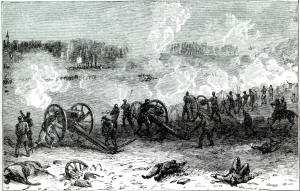Sheridan had seized the point at Cold harbor, and the Nationals took a
position extending from beyond the Hanover road to Elder Swamp Creek, not
far from the Chickahominy.
Burnside's corps composed the right of the line,
Warren's and Wright's the center, and
Hancock's the left. The Confederate
line, reinforced by troops under General
John C. Breckinridge, occupied a line in front of the Nationals—Richard
Ewell's corps on the left, James
Longstreet's in the center, and
A. P. Hill's on the right. On
the morning of June 1, 1864, Hoke's division attempted to retake Cold
Harbor. It was repulsed, but was reinforced by McLaws's division. Wright's
6th Corps came up in time to meet this new danger: and Smith's troops from
the Army of the James, after a march of 25 miles, came up and took post on
the right of the 6th Corps, then in front of Cold Harbor, on the road
leading to Gaines's Mills. Between the two armies was a broad, open,
undulating field and a thin line of woods. Over this field the Nationals
advanced to the attack at 4 P.m. The veterans of Smith soon captured the
first line of riflepits and 600 men. Their attack on the second line was a
failure, and with darkness the struggle ceased, the Nationals having lost
2,000 men. They held the ground, and bivouacked on the battlefield.
During the night the Confederates made desperate but unsuccessful efforts to
retake the riflepits. General Grant had ordered a redisposition of his army,
making Hancock form the right, to the right of Wright's corps. Burnside was
withdrawn entirely from the front and placed on the right and rear of
Warren, who connected with Smith. Having made these dispositions on the 2nd,
it was determined to force the passage of the Chickahominy the next morning,
and compel Lee to seek safety in the
fortifications around Richmond. The Nationals moved at four o'clock on the
morning of the 3rd. Wilson's cavalry was on the right flank, and Sheridan's
held the lower crossings of the river, and covered the roads to the White
House. Orders had been given for a general assault along the whole line. At
half-past four, or a little later, the signal for the advance was given, and
then opened one of the most sanguinary battles of the war. It was begun on
the right by the divisions of Barlow and Gibbon, of Hancock's corps,
supported by Birney's. Barlow drove the Confederates from a strong position
in front of their works, and captured several hundred men and three guns,
when the Confederates rallied and retook the position. General Gibbon, who
charged at the same time, was checked by a marsh of the Chickahominy which
partly separated and weakened his command, and part of them gained the
Confederate works, but could not hold them. There was a severe struggle, and
in the assaults Hancock lost 3,000 men. The other divisions of the army were
hotly engaged at the same time. The battle was " sharp, quick, and
decisive." The Nationals were repulsed at nearly every point with great
slaughter. It was estimated that within the space of twenty minutes after
the struggle began 10,000 Union soldiers lay dead or wounded on the field,
while the Confederates, sheltered by their works, had not lost more than
1,000. And so, at one o'clock in the afternoon of June 3, 1864, the battle
of Cold Harbor ended.
It was one of the most sanguinary struggles of the great Civil War. The
Nationals had a fearful loss of life, but firmly held their position, with
all their munitions of war. Their loss in this engagement, and in the
immediate vicinity of Cold Harbor, was reported at 13,153, of whom 1,705
were killed and 2,406 were missing. Immediately after the battle Sheridan
was sent to destroy the railways in
Lee's rear, and so make Washington more secure. This task he effectually
performed, fighting much of the time.
Grant then resolved to transfer his
army to the south side of the James River. |
